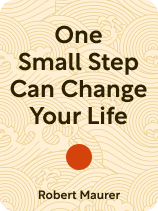

This article is an excerpt from the Shortform book guide to "One Small Step Can Change Your Life" by Robert Maurer. Shortform has the world's best summaries and analyses of books you should be reading.
Like this article? Sign up for a free trial here.
Is it hard for you to turn your ideas into action? Could positive visualization be the key to reaching your potential?
Imagine rehearsing your goals in your mind before taking the first step. Positive visualization is a powerful technique that can prepare you mentally for new challenges and skills. It’s like a dress rehearsal for your brain, making the unfamiliar feel more achievable.
Keep reading to discover how this mental practice can transform your life.
Positive Visualization
You might have lots of ideas for implementing change. But, what if you’re hesitant to act on these ideas? Robert Maurer suggests that you mentally prepare yourself to move forward by visualizing the steps you want to take. Positive visualization is a form of mental rehearsal, readying your mind to adopt new skills and behaviors. It works because your brain can’t distinguish between real and vividly imagined experiences, which means it processes visualizations as if they’re actual experiences.
This technique is particularly useful for developing new skills because each visualization session encourages your brain to practice and refine the skills you’re imagining, much like physical practice. For example, visualizing yourself playing the piano can enhance your dexterity as effectively as if you were sitting at the keyboard for a lesson. And, Maurer says, with regular repetition, the actions you envision feel more familiar and natural, which makes it easier to perform them in the real world.
(Shortform note: Research supports the effectiveness of this strategy: Visualization mentally prepares you to take action by activating the same parts of your brain that actually doing the activity would. For example, thinking about your body moving in some way, like raising your hand or taking a step forward, activates your motor cortex, the part of your brain that directs such movements. Imagining a movement primes your body to do it with greater control and coordination. Additionally, the research suggests that visualization makes it easier to take action because it improves motivation, raises confidence, and reduces anxiety.)
Integrate Visualization Into Your Routine
Maurer suggests that the key to effective visualization is repetition and gradual progression. He recommends the following process for integrating visualization into your routine:
- Select a task that you feel nervous about and allocate a few seconds each day to visualization.
- During each session, close your eyes and imagine yourself performing the task. Engage all of your senses—see, hear, smell, touch, and feel emotions just as if you were acting in real life.
- Imagine positive outcomes, such as successfully completing the task or receiving a favorable response from others.
- As you grow more comfortable, gradually increase the duration of your sessions. Then, start to weave in challenges, such as potential obstacles or worst-case scenarios, and visualize yourself managing them effectively.
| Positive Visualization Can Hinder Your Progress Some psychologists suggest that you’re more likely to benefit from visualization by imagining yourself overcoming obstacles (step 4) than imagining positive outcomes (step 3). During experiments testing the effects of visualization, researchers noted that, when subjects used positive visualization techniques, their motivation to achieve their goal decreased, making them more likely to abandon their project. In contrast, subjects who either visualized negative things or thought about the possibility that they might not achieve their goal had higher energy levels and accomplished more. The researchers speculate that this is because visualizing a positive outcome has a relaxing effect on the body. However, if your goal is to accomplish something that requires energy and action, such relaxation techniques can be counterproductive. It’s better to prepare yourself mentally for the challenges you face so that your mind gathers the strength and stamina you’ll need to face those challenges. |

———End of Preview———
Like what you just read? Read the rest of the world's best book summary and analysis of Robert Maurer's "One Small Step Can Change Your Life" at Shortform.
Here's what you'll find in our full One Small Step Can Change Your Life summary:
- Why it's often difficult to make the changes you want
- How to avoid your fight-or-flight response and move forward instead
- Simple strategies to transform seemingly daunting goals into enjoyable and attainable ones






